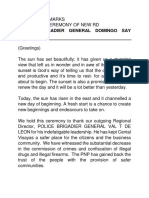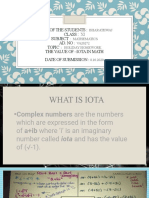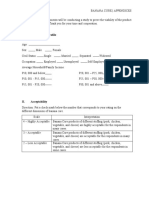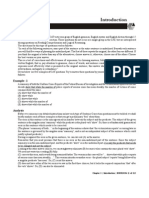Scientific Notation Is A Way of Writing Numbers That Is Often Used by Scientists and
Scientific Notation Is A Way of Writing Numbers That Is Often Used by Scientists and
Uploaded by
JFACopyright:
Available Formats
Scientific Notation Is A Way of Writing Numbers That Is Often Used by Scientists and
Scientific Notation Is A Way of Writing Numbers That Is Often Used by Scientists and
Uploaded by
JFAOriginal Description:
Original Title
Copyright
Available Formats
Share this document
Did you find this document useful?
Is this content inappropriate?
Copyright:
Available Formats
Scientific Notation Is A Way of Writing Numbers That Is Often Used by Scientists and
Scientific Notation Is A Way of Writing Numbers That Is Often Used by Scientists and
Uploaded by
JFACopyright:
Available Formats
JAYANNAH MARIA I.
ARANDIA
Scientific notation is a way of writing numbers that is often used by scientists and
mathematicians to make it easier to write large and small numbers. A number that
is written in scientific notation has several properties that make it very useful to local
scientists. It makes very large numbers into smaller numbers using decimals and
exponents.
Variations
The basic idea of scientific notation is to express zeros as a power of ten. The
notation for this can be written as : where b is an integer, or "whole"
number, that describes the number of times 10 is multiplied by itself and the letter
a any real number, called the significand or mantissa (using "mantissa" may cause
confusion as it can also refer to the fractional part of the common logarithm).
Normalized notation
Written in the form a × 10b, exponent b is chosen such that the absolute value of a
remains at least one but less than ten . Normal mathematics
convention dictates a minus sign to precede the first of the decimal digits of a for a
negative number; that of b for a number with absolute value between 0 and 1, e.g.
minus one half is -5 × 10-1. There is no need to represent zero in normalized form,
the digit 0 is sufficient. The normalized form allows easy comparison of two numbers
of the same sign in a, as the exponent b gives the number's order of magnitude.
Scientific notation is used for expressing large quantities, such as the speed of
light, or very small quantities, such as the surface area of an atom. Scientific
notation is much more practical to use in writing and calculation because it saves
you the tedious time involved in writing a succession of zero’s. It also helps to
prevent a mistake in miscounting that can occur when you are trying to keep track
of a large amount of zero’s.
Scientific notation is very important to modern society because of the practicality it
provides to people working with these numbers. Scientists, engineers and chemists
are just a few examples of people who regularly use scientific notation in modern
day society. Comment: Practical uses of scientific notation are used anytime that
you want to express a number that is big or even small. It is much easier to read
than a number that has 14 zeros before or after a decimal point. Counting too many
zeros would really get confusing and sometimes get lost in between, thereby
leading to inaccuracies. This allows scientists and other people who work with very
big and very small numbers to handle them without having to write down a lot of
digits. Astronomers use it when measuring distances to other stars and galaxies.
Geologists may use it to measure the age of rocks. In modern day society, the
scientific notation is good for scientists, mathematicians, and engineers to use big
or small numbers.
You might also like
- Resort Business PlanDocument42 pagesResort Business Plansalesbaliharmony100% (1)
- Mirror ShadesDocument180 pagesMirror ShadesThiago Zanotti67% (3)
- Welcome Remarks Turn-Over of New RD For DrdaDocument2 pagesWelcome Remarks Turn-Over of New RD For DrdaJFA100% (6)
- Lab Man 2426 So 2013Document135 pagesLab Man 2426 So 2013SpoodieNo ratings yet
- Carburetor Definition PDFDocument12 pagesCarburetor Definition PDFAhtisham Amjad100% (2)
- SAMS Photofact Index PDFDocument22 pagesSAMS Photofact Index PDFBillyBob Sowbreath0% (1)
- Dcd-I HVDCDocument3 pagesDcd-I HVDCsatya_vanapalli3422No ratings yet
- Bracing Supplement Document: GIB Bracing Design NotesDocument22 pagesBracing Supplement Document: GIB Bracing Design NotesJimuel MejicaNo ratings yet
- Manu Kant: Executive SummaryDocument6 pagesManu Kant: Executive SummarymanukleoNo ratings yet
- Real Number SystemDocument18 pagesReal Number Systemrandeepa srimanthaNo ratings yet
- Maths Project 2023Document27 pagesMaths Project 2023priyanshu jizNo ratings yet
- A Number Is A Mathematical Object Used in Counting and MeasuringDocument28 pagesA Number Is A Mathematical Object Used in Counting and MeasuringDivakar ReddyNo ratings yet
- Classification of NumbersDocument8 pagesClassification of NumbersArijit PanigrahyNo ratings yet
- Scientific NotationDocument2 pagesScientific NotationDab Dab litNo ratings yet
- 8th Grade MathDocument4 pages8th Grade Mathcircleteam123No ratings yet
- D 96 SymbolsInMathDocument5 pagesD 96 SymbolsInMathAlexis V. LarosaNo ratings yet
- The Real Number SystemDocument32 pagesThe Real Number SystemviksoniNo ratings yet
- Floating Point: Significant Digits × BaseDocument17 pagesFloating Point: Significant Digits × Basesavio77No ratings yet
- Top 10 Mathematic Ideas Every Programmer Should Master - by CodeCircuit - Apr, 2023 - JavaScript in Plain EnglishDocument21 pagesTop 10 Mathematic Ideas Every Programmer Should Master - by CodeCircuit - Apr, 2023 - JavaScript in Plain EnglishThành Sơn VõNo ratings yet
- NumbDocument25 pagesNumbZulkifli Paldana AkbarNo ratings yet
- C3 Basic Arithmetic OperationsDocument14 pagesC3 Basic Arithmetic Operationscubic.meter.85No ratings yet
- Paper of History of MathematicsDocument8 pagesPaper of History of MathematicsmaisarahNo ratings yet
- Math ThesisDocument91 pagesMath ThesisBinodBasnetNo ratings yet
- Rational and Irrational NumbersDocument11 pagesRational and Irrational NumbersRoberta Gonzales SisonNo ratings yet
- Number - WikipediaDocument86 pagesNumber - WikipediaaasifNo ratings yet
- The Nature of NumbersDocument16 pagesThe Nature of Numbersvampire88No ratings yet
- Polynomials and DefintionsDocument25 pagesPolynomials and DefintionsCalvin ChuNo ratings yet
- BOOK - Ideas of MathematicsDocument307 pagesBOOK - Ideas of Mathematicssupriyono.bonhamNo ratings yet
- Chapter 2Document14 pagesChapter 2LIGAWAD, MELODY P.No ratings yet
- Standard FormDocument6 pagesStandard FormSarah SrhNo ratings yet
- 3-Laboratory and Reporting SkillsDocument97 pages3-Laboratory and Reporting Skillsprod rxckyNo ratings yet
- 1.3-1 Basic MathematicsDocument7 pages1.3-1 Basic MathematicsRhea F. ParajesNo ratings yet
- Mathematics Investigatory Project: Irrational and Rational NumbersDocument16 pagesMathematics Investigatory Project: Irrational and Rational NumbersRichlie Natividad100% (2)
- Scientific Notation WikipediaDocument8 pagesScientific Notation WikipediaArte Y MecatrónicaNo ratings yet
- bk978 0 7503 3287 3ch1 PDFDocument12 pagesbk978 0 7503 3287 3ch1 PDFDilham WahyudiNo ratings yet
- Algebra - BoundlessDocument784 pagesAlgebra - BoundlessklingonNo ratings yet
- Guidelines in Writing Mathematical ProofDocument5 pagesGuidelines in Writing Mathematical ProofYvonne GuintodanNo ratings yet
- Basic MathsDocument34 pagesBasic MathsBryanNo ratings yet
- Math Language and SymbolsDocument13 pagesMath Language and SymbolsCJ EbuengaNo ratings yet
- MathDocument4 pagesMathDALOGDOG, Mary Faith C. 11-AquilaNo ratings yet
- 1) Mathematical Language PDFDocument5 pages1) Mathematical Language PDFarya_dutta_royNo ratings yet
- Transcript - Scientific NotationDocument3 pagesTranscript - Scientific NotationJohn VictorNo ratings yet
- Ccuracy and Speed: HapterDocument14 pagesCcuracy and Speed: HapterCarl ScottNo ratings yet
- Week 4 The Real Number SystemDocument7 pagesWeek 4 The Real Number SystemNur AnatiNo ratings yet
- Difenition of Discrete MathDocument10 pagesDifenition of Discrete MathAaron Jade SunglaoNo ratings yet
- CH 1 Number System and Numerical Error AnalysisDocument10 pagesCH 1 Number System and Numerical Error AnalysisAmanuel FekaduNo ratings yet
- The Real Number SystemDocument36 pagesThe Real Number SystemKalson UmpuNo ratings yet
- Artikel MTKDocument4 pagesArtikel MTKDedi SatriaNo ratings yet
- Floating Point: Significant Digits × BaseDocument25 pagesFloating Point: Significant Digits × BaseRavindra KumarNo ratings yet
- Conclusion (Addmaths Project) LogarithmDocument2 pagesConclusion (Addmaths Project) Logarithmkarwei5750% (4)
- Lecture Notes On Numerical Methods For Engineering (?) : Pedro Fortuny AyusoDocument104 pagesLecture Notes On Numerical Methods For Engineering (?) : Pedro Fortuny AyusoFlaviaNo ratings yet
- Types of NumbersDocument4 pagesTypes of NumbersSha MercsNo ratings yet
- Unit 1Document26 pagesUnit 1Roxane EsguerraNo ratings yet
- Chapter 1 - 2Document64 pagesChapter 1 - 2hafabaNo ratings yet
- How To Calculate Log and AntilogDocument18 pagesHow To Calculate Log and AntilogRahul AnandNo ratings yet
- Name of The Students Class: Subject Ad. No Topic The Value of - Iota in Math Date of SubmissionDocument21 pagesName of The Students Class: Subject Ad. No Topic The Value of - Iota in Math Date of SubmissionBharathwajNo ratings yet
- Gical - A2 - Nestor MaximoDocument8 pagesGical - A2 - Nestor MaximoNestor Maximo VicenteNo ratings yet
- Applied StatisticsDocument8 pagesApplied StatisticsEly Boy AntofinaNo ratings yet
- Natural NumberDocument8 pagesNatural NumberkentbnxNo ratings yet
- IEEE Floating PointDocument20 pagesIEEE Floating PointMario MauriesNo ratings yet
- Rational and Irrational NumbersDocument4 pagesRational and Irrational NumbersnishagoyalNo ratings yet
- Types of Numbers PDFDocument11 pagesTypes of Numbers PDFPoonam Kumari100% (1)
- Feasibility Study QuestionnaireDocument3 pagesFeasibility Study QuestionnaireJFA100% (1)
- Comets, Meteors & Asteroids: Science 8Document13 pagesComets, Meteors & Asteroids: Science 8JFANo ratings yet
- SECTIONS 133, 193, 232, and 234 of RA 7160Document5 pagesSECTIONS 133, 193, 232, and 234 of RA 7160JFANo ratings yet
- Memorandum For Prosecution - CLE 2 Final AssignmentDocument5 pagesMemorandum For Prosecution - CLE 2 Final AssignmentJFANo ratings yet
- Memorandum Ra 9165Document5 pagesMemorandum Ra 9165JFANo ratings yet
- Memorandum Ra 9165 2Document7 pagesMemorandum Ra 9165 2JFANo ratings yet
- Welcome and Congratulatory Dinner For The Newly Assigned and Promoted Lakans Message of DrdaDocument2 pagesWelcome and Congratulatory Dinner For The Newly Assigned and Promoted Lakans Message of DrdaJFANo ratings yet
- Welcome Remarks RD Ferro 1st Command ConferenceDocument1 pageWelcome Remarks RD Ferro 1st Command ConferenceJFANo ratings yet
- Heine V New YorkDocument7 pagesHeine V New YorkJFANo ratings yet
- Welcome Remarks RD Ferro 1st Command ConferenceDocument1 pageWelcome Remarks RD Ferro 1st Command ConferenceJFANo ratings yet
- HSBC V Sheman DigestDocument2 pagesHSBC V Sheman DigestJFANo ratings yet
- Quality of Work LifeDocument99 pagesQuality of Work Lifefelix777sNo ratings yet
- Ficha Tecnica Cacao PolvoDocument2 pagesFicha Tecnica Cacao PolvofernandagbNo ratings yet
- Research On Airport Security Based On Virtual Queuing TheoryDocument5 pagesResearch On Airport Security Based On Virtual Queuing TheorySunil SagarNo ratings yet
- ISA 7.0 Quality Standard For Instrument Air PDFDocument34 pagesISA 7.0 Quality Standard For Instrument Air PDFRishiBaldeo100% (1)
- TERM PAPER - DBMS NDocument5 pagesTERM PAPER - DBMS NMD ShohagNo ratings yet
- Victoria Guillén-Nieto, Hate Speech - Linguistic PerspectivesDocument210 pagesVictoria Guillén-Nieto, Hate Speech - Linguistic PerspectivesChrisNo ratings yet
- Mack MP7, MP8, MP10 Engines Overhaul Part Numbers Reference Guide Vol 16013B MACKDocument2 pagesMack MP7, MP8, MP10 Engines Overhaul Part Numbers Reference Guide Vol 16013B MACKviemey1952100% (2)
- B550 PG VelocitaDocument99 pagesB550 PG VelocitaEduardo RigueraNo ratings yet
- 3 Render's Esu PDFDocument13 pages3 Render's Esu PDFEugenius BreidenNo ratings yet
- 2021-Rates of Contributory de Novo Mutation in High and Low-Risk Autism Families.Document10 pages2021-Rates of Contributory de Novo Mutation in High and Low-Risk Autism Families.熊佳仪(不冬眠的熊)No ratings yet
- How Roles and Functions Contribute To Organisational PerformanceDocument4 pagesHow Roles and Functions Contribute To Organisational PerformanceIzza AhmadNo ratings yet
- A Painted Town Wall Paintings and The Bu PDFDocument13 pagesA Painted Town Wall Paintings and The Bu PDFMaria V.No ratings yet
- Example - 1: Chapter 1 - Introduction - BMM10204 - 1 of 112Document7 pagesExample - 1: Chapter 1 - Introduction - BMM10204 - 1 of 112Sayan DattaNo ratings yet
- Detailed Lesson Plan Science Kindergarten 2 Prepared By: Joharah Tindegaranao Dumangcag I. ObjectivesDocument4 pagesDetailed Lesson Plan Science Kindergarten 2 Prepared By: Joharah Tindegaranao Dumangcag I. ObjectivesJoharah DumangcagNo ratings yet
- Space Mission Analysis: Dr. Andrew Ketsdever MAE 5595Document40 pagesSpace Mission Analysis: Dr. Andrew Ketsdever MAE 5595Mohd Fazri Sedan100% (1)
- FC Assignment 07 Acid StrengthDocument4 pagesFC Assignment 07 Acid StrengthHarsh Vardhan Singh100% (1)
- Problem Solving Using IRACDocument9 pagesProblem Solving Using IRACthroux100% (1)
- AmishDocument16 pagesAmishapi-602260400No ratings yet
- SM1001902Document110 pagesSM1001902Rahul barodNo ratings yet
- 25th Dhil-Hajj Abu Al Moghith Al Husain Ibn Mansur Al Hallaj RadiAllahAnhoDocument7 pages25th Dhil-Hajj Abu Al Moghith Al Husain Ibn Mansur Al Hallaj RadiAllahAnhoHussain AliNo ratings yet
- l4 Complementary DietDocument45 pagesl4 Complementary DietNur Ainaa100% (1)
- Writing SkillsDocument30 pagesWriting SkillsMizter'Lar IntavanhNo ratings yet
- Pharmacognosy Chapter 7 Traditional System of Medicine Ayurvedic Preparations NotesDocument13 pagesPharmacognosy Chapter 7 Traditional System of Medicine Ayurvedic Preparations NotesAbhishek palNo ratings yet





































































































